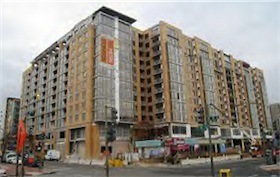The Next Boom
Patrick Doherty and Christopher Leinberger have a great piece in the Washington Monthly about the potentially bright future for walkable urban real estate development. They observe that population growth plus the declining proportion of Americans who have kids at home plus shifting preferences among young people (driven in part by declining crime rates, etc.) are creating a boom in demand for walkable transit-accessible neighborhoods:
Ten years ago, the highest property values per square foot in the Washington, D.C., metro area were in car-dependent suburbs like Great Falls, Virginia. Today, walkable city neighborhoods like Dupont Circle command the highest per-square-foot prices, followed by dense suburban neighborhoods near subway stops in places like Bethesda, Maryland, and Arlington, Virginia. Similarly, in Denver, property values in the high-end car-dependent suburb of Highland Ranch are now lower than those in the redeveloped LoDo neighborhood near downtown. These trend lines have been evident in many cities for a number of years; at some point during the last decade, the lines crossed. The last time the lines crossed was in the 1960s—and they were heading the opposite direction.
In principle, these shifts in demand should lead to a large quantity of economic activity in the field of "retrofitting" existing neighborhoods with more robust transit links and more intensive development. But:
Today, even though consumer preferences have changed, most of the old rules and subsidies remain in place. For instance, federal transportation funding formulas, combined with the old-school thinking of many state departments of transportation, continue to favor the building of new roads and widening of highways—infrastructure that supports low-density, car-dependent development—over public transit systems that are the foundation for most compact, walkable neighborhoods. When developers do propose to build denser projects, with narrower streets and apartments above retail space, they often run up against zoning codes that make such building illegal. Consequently, few compact, walkable neighborhoods have been built relative to demand, and real estate prices in them have often been bid up to astronomical heights. This gives the impression that such neighborhoods are only popular with the affluent, when in fact millions of middle-class Americans would likely jump at the opportunity to live in them.
As an analyst of public policy issues, I certainly hope this turns around and anyone who reads this blog will know I'm doing my best to persuade people to rethink this. As a condo owner in a very new building in a newly developing dense walkable neighborhood (as in it was literally vacant lots, rather than a classic gentrification scenario) who reads his building email list, I'm a bit skeptical that change is going to happen. Even people who are eager to move to denser urban neighborhoods are almost shockingly hostile to the idea of anything in the existing neighborhood being redeveloped in a denser way. So it seems to me that any change that happens, if it does happen, will have to take place on a longer time horizon than Doherty and Leinberger seem to have in mind since there's a lot of persuasion work that has to be done.
But speaking of persuasion, Leinberger's short book The Option of Urbanism: Investing in a New American Dream did a lot to change my thinking about this topic and it's highly recommended.


Matthew Yglesias's Blog
- Matthew Yglesias's profile
- 72 followers




